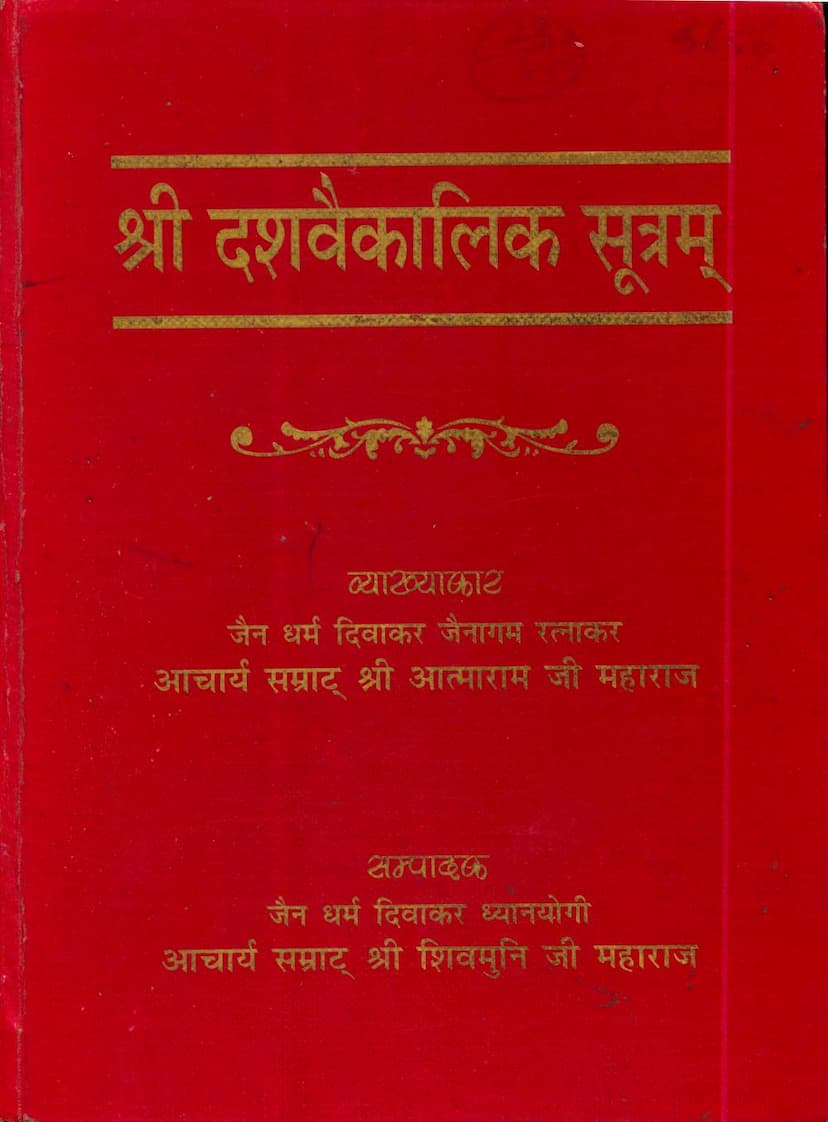Dashvaikalaik Sutram
Added to library: September 1, 2025

Summary
The provided Jain text is the "Dashvaikalaik Sutram," a significant Jain scripture. The text you've supplied is a preface and commentary on this sutra, with extensive introductory materials, explanations of its origins, contents, and importance.
Here's a comprehensive summary in English, based on the provided pages:
Dashvaikalaik Sutram: A Summary
The "Dashvaikalaik Sutram" (also transliterated as Dashvaikalik Sutram) is a revered Jain scripture attributed to Acharya Seyyambhava, a disciple of Prabha Swami and the fourth spiritual successor in the Jain lineage. The text is a significant part of the Jain Agamas and is particularly valued for its focus on the conduct and ethics of Jain ascetics (monks and nuns).
Key Aspects and Content:
-
Authorship and Lineage: The text is credited to Acharya Seyyambhava, a scholar who was also a predecessor in the line of Jain pontiffs. The commentary and editing of this particular edition are attributed to the esteemed Acharya Samrat Shri Aatmaram Ji Maharaj and Acharya Samrat Shri Shiv Muni Ji Maharaj. The publication is by the "Atma-Gyan-Shraman-Shiv-Agam-Prakashan-Samiti."
-
Significance of Agamas: The introductory material emphasizes the immense importance of Jain Agamas as invaluable treasures of Jain philosophy. They are described as divine light guiding humanity through the darkness of ignorance, teaching the art of living, and serving as the voice of the Arhats (omniscient beings).
-
Historical Context: The text touches upon the historical tradition of preserving Jain knowledge through oral transmission (shrut). It acknowledges the eventual need for scriptural codification after the Nirvana of Lord Mahavir, mentioning the three significant councils (Vachanas) that took place to compile the Agamas. These councils led to the division of Jain literature into six categories: 12 Angas, 12 Upangas, 10 Prakirna Sutras, 6 Chheda Sutras, 4 Moola Sutras, and 2 Chulika Sutras. The Dashvaikalaik Sutra is identified as one of the four Moola Sutras.
-
Origin of the Dashvaikalaik Sutra: A notable point highlighted is the origin of this specific sutra. Acharya Seyyambhava, upon becoming a monk, learned that his pregnant wife had given birth to a son named Manaka. Through his spiritual insight, Acharya Seyyambhava foresaw that Manaka had only six months of life remaining. To facilitate Manaka's spiritual liberation within that short span, Acharya Seyyambhava composed the Dashvaikalaik Sutra. It is believed that by studying this sutra, Manaka attained the desired spiritual knowledge within those six months.
-
Authenticity and Importance: The authenticity of the Dashvaikalaik Sutra is supported by references in other foundational Jain texts like the Kalpasutra, Mahānisiatha Sutra, and Nandi Sutra. Its significance is further underscored by the fact that it is equally revered and studied by all major sects of Jainism: Shvetambaras, Digambaras, and Terapanthis, often being the first scripture taught to new ascetics.
-
Content and Themes:
- Code of Conduct for Ascetics: The Dashvaikalaik Sutra is primarily an ethical guide for Jain ascetics, detailing their conduct, practices, and spiritual journey.
- Key Themes: The text addresses crucial aspects of ascetic life, including:
- The importance of steadfastness in their ascetic path (Sanyam-yatra).
- The necessity of wisdom and diligence in their practice of begging for alms (Bhiksha-vritti).
- The significance of the Guru and the disciple's respectful conduct towards them.
- The need to abstain from sensual pleasures, especially association with women.
- The importance of internal qualities like knowledge, compassion, truthfulness, and good conduct.
- The adherence to the five great vows (Mahavratas), with a particular emphasis on non-violence (Ahimsa) and compassion.
- The dangers of worldly desires like wealth and attachment.
- The encouragement of internal discipline, austerity, and meditation.
- The pursuit of spiritual upliftment and ultimate liberation (Moksha).
- Style and Language: The sutra is composed in Ardha-Magadhi, a Prakrit language. It is noted for its lyrical, free-verse style, blending prose and poetry, and occasionally incorporating narrative elements like the story of Rajmati and Rathnemi, hinting at a "prabandh-shaili" (narrative style). The language is praised for its clarity, brevity, apt word choice, and the beautiful use of proverbs and aphorisms (Sūktis).
- Mangal-Charan (Invocation): The text deviates from traditional invocations by directly saluting Dharma, Ahimsa, Sanyam, and Tapas, emphasizing them as the ultimate auspicious entities, even worthy of worship by gods.
- Analysis of Chapters: The introduction provides a brief overview of the subject matter of each of the ten chapters, covering themes like the praise of Dharma, patience in asceticism, self-control, protection of the six types of living beings, pure alms-gathering, stories of great ascetics, teachings for the knowledgeable, principles of conduct, the importance of humility and respect, and concluding with the characteristics of an ideal mendicant (Bhav-Bhikshu).
- Source of Chapters: There are differing views on the original sources of each chapter, with some attributing them to the Purvas and others to the Dwadasangi (the 12 Angas). Acharya Aatmaram Ji Maharaj, based on his research, posits that the chapters draw from various Agamas, including the Anu-yoga Sutra, Uttaradhyayana Sutra, Nishith Sutra, Samavāyānga Sutra, and Sthānānga Sutra.
-
Commentary and Publication: The provided text is a Hindi translation and commentary (Atma-Gyan-Prakashika) by Acharya Samrat Shri Aatmaram Ji Maharaj, with editing by Acharya Samrat Shri Shiv Muni Ji Maharaj. The publication aims to make this valuable scripture accessible to the Jain community, fulfilling a long-standing desire among ascetics for its widespread availability.
-
The Lohatia Family's Contribution: The publication of this text is credited to the generosity of Mrs. Sushila Behen Lohatia, continuing her family's long tradition of service to religion and the Agamas.
Overall Purpose:
The Dashvaikalaik Sutram, as presented in this edition, serves as a profound spiritual and ethical guide, particularly for ascetics, aiming to inspire the study and practice of Jain principles for the attainment of liberation. It meticulously details the path of righteousness, self-control, and detachment, offering profound insights into the Jain way of life.